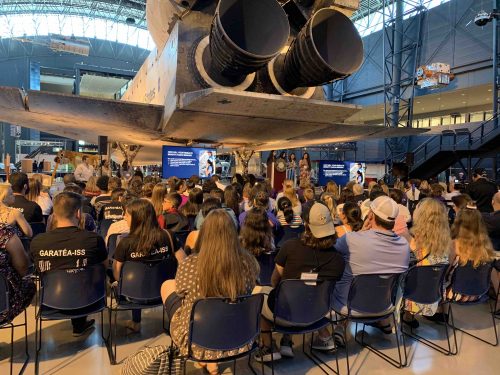
Student Flight Team from Corcoran, CA, presenting at the SSEP 2019 National Conference. The conference took place under Space Shuttle Discovery at the Smithsonian National Air and Space Museum, a national partner on SSEP.
These pages provide SSEP student research teams a public forum where they can report on their microgravity experiment designs, experiment refinement, and experimental results. Here you will find a video archive of conference presentations, and in some cases scholarly research papers – which are the two main vehicles that are used by professional researchers to communicate research status and scientific results to the global research community. The conference presentations are oral presentations by SSEP teams at the Annual SSEP National Conference at the Smithsonian National Air and Space Museum, and are taped by the Smithsonian and archived on YouTube.
A video compilation of poster sessions conducted by SSEP student research teams in the Space Race gallery at the National Air and Space Museum during the July 2012 Annual SSEP National Conference.
Overarching Pedagogy – A Context
The Student Spaceflight Experiments Program (SSEP) is about inspiring and engaging the next generation of scientists and engineers by immersing students in authentic scientific research. Through this program, the National Center for Earth and Space Science Education invites communities of students at the local level, starting with grade 5, to fully take on the mantle of real researchers, and experience every facet of scientific research. This pedagogical approach reflects the belief that exploration as practiced by professional scientists and engineers grows organically from what it means to be human, embracing the innate human characteristics of curiosity and evidence-based learning – which we exhibit from birth. In this context, we recognize that our students – even at the elementary school level – are fully capable of doing science, and in fact do science on a daily basis as they navigate their world, though they may not recognize it as “science”.
The Center created SSEP as a means of embedding the authentic research experience in formal education, so that ownership in learning, inquiry-based exploration, critical thinking, teamwork, and exploration of inter-disciplinary landscapes, can be extended to the formal classroom environment using a project-based approach. Most importantly, these are the skills that characterize jobs of the 21st century, yet merely reflect a natural extension of what it means to be human. We believe that this is a pedagogical recipe for success to establish a next generation of researchers, and a scientifically literate public that will be asked to make critical decisions on the use of science and technology affecting our community, our nation, and our world.
SSEP allows student teams to design a real research program – in this case a real microgravity experiment – like scientists, with real constraints imposed by the experimental apparatus, current knowledge, and the environment in which the experiment will be conducted; it allows students to formally propose for a real spaceflight opportunity for their experiment like professional scientists, bringing critical written communications skills to bear; it allows students to experience a real 2-step science proposal review process; it allows students to go through a real flight safety review like professional researchers; it provides students their own science conference, where they are immersed in their community of researchers, communicating their thoughts, ideas, and experimental results to their peers; and it provides a public forum for scientific papers written by student research teams.
Science is a way of thinking about, interacting with, and exploring the natural world. And the practice of scientific exploration is a complex social landscape filled with challenges, and the need for multi-faceted and successful communication with ones peers. Science is far more than a book of knowledge. In fact it has never been a book of knowledge. Science is journey, and SSEP is charged with immersing our students in that journey.
Jump to:
Conference Poster Presentation Compilations page
Scientific Return and Reporting: SSEP Mission 13 to ISS page
Scientific Return and Reporting: SSEP Mission 12 to ISS page
Scientific Return and Reporting: SSEP Mission 11 to ISS page
Scientific Return and Reporting: SSEP Mission 10 to ISS page
Scientific Return and Reporting: SSEP Mission 9 to ISS page
Scientific Return and Reporting: SSEP Mission 8 to ISS page
Scientific Return and Reporting: SSEP Mission 7 to ISS page
Scientific Return and Reporting: SSEP Mission 6 to ISS page
Scientific Return and Reporting: SSEP Mission 5 to ISS page
Scientific Return and Reporting: SSEP Mission 4 to ISS page
Scientific Return and Reporting: SSEP Mission 3 to ISS page
Scientific Return and Reporting: SSEP Mission 2 to ISS page
Scientific Return and Reporting: SSEP Mission 1 to ISS page
